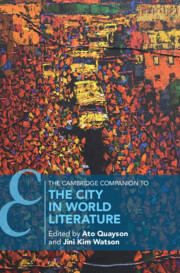Book contents
- The Cambridge Companion to the City in World Literature
- The Cambridge Companion to the City in World Literature
- Copyright page
- Contents
- Contributors
- Chronology of Political, Literary, and Cultural Events
- Chapter 1 Introduction
- Part I Critical Approaches
- Part II Spotlight Literary Cities
- Chapter 5 The Neighborhood and the Sweatshop
- Chapter 6 “The Whole World in Little”
- Chapter 7 Unworlding Paris
- Chapter 8 Sketching the City with Words
- Chapter 9 Romance and Liminal Space in the Twentieth-Century Cairo Novel
- Chapter 10 Bombay/Mumbai and its Multilingual Literary Pathways to the World
- Chapter 11 At Home in the World
- Chapter 12 Imagining the Migrant in Twenty-First Century Johannesburg
- Chapter 13 Russia
- Chapter 14 “Cityful Passing Away”
- Chapter 15 From Altepetl to Megacity
- Chapter 16 (In)Visible Beijing Within and Without World Literature
- Chapter 17 Worlding Lagos in the Long Twentieth Century
- Chapter 18 Haunted Vitality
- Select Bibliography
- Index
- Cambridge Companions To …
Chapter 16 - (In)Visible Beijing Within and Without World Literature
from Part II - Spotlight Literary Cities
Published online by Cambridge University Press: 13 July 2023
- The Cambridge Companion to the City in World Literature
- The Cambridge Companion to the City in World Literature
- Copyright page
- Contents
- Contributors
- Chronology of Political, Literary, and Cultural Events
- Chapter 1 Introduction
- Part I Critical Approaches
- Part II Spotlight Literary Cities
- Chapter 5 The Neighborhood and the Sweatshop
- Chapter 6 “The Whole World in Little”
- Chapter 7 Unworlding Paris
- Chapter 8 Sketching the City with Words
- Chapter 9 Romance and Liminal Space in the Twentieth-Century Cairo Novel
- Chapter 10 Bombay/Mumbai and its Multilingual Literary Pathways to the World
- Chapter 11 At Home in the World
- Chapter 12 Imagining the Migrant in Twenty-First Century Johannesburg
- Chapter 13 Russia
- Chapter 14 “Cityful Passing Away”
- Chapter 15 From Altepetl to Megacity
- Chapter 16 (In)Visible Beijing Within and Without World Literature
- Chapter 17 Worlding Lagos in the Long Twentieth Century
- Chapter 18 Haunted Vitality
- Select Bibliography
- Index
- Cambridge Companions To …
Summary
On and off the map of “the world republic of letters,” literary Beijing, from exotic configurations to multivalent self-portraits, has unfolded, historically and geopolitically, as an ancient capital of traditional China, a Republican city of new thoughts and everlasting memories, a fallen city under Japanese military control, a socialist capital of Maoist ideology, and a rejuvenated and cosmopolitan megacity in the post-Cold War era and the new millennium. This chapter situates Beijing writing in the intertwined contexts of Chinese literature and World Literature in terms of evidenced influences, implicit connections, and paralleled representations. The methods of imagining Beijing have formed in the multilayered city-texts by writers across different historical times, which entailed variegated genres, ideas and trends, places and spaces, emotions and materiality, and cultural chronotopes. Entangled with Beijing narratives created by authors across the globe, the city’s imageries in Chinese literature prompt intriguing dialogues, in both visible and invisible ways, with World Literature. Together, this tapestry of urban writing encodes and decodes Beijing as a real, imagined, mythical, metaphorical and semiotic city surviving barbarianism, exoticism, Orientalism, (mis)understanding, (over)interpretation, and (un)translatability.
- Type
- Chapter
- Information
- The Cambridge Companion to the City in World Literature , pp. 248 - 263Publisher: Cambridge University PressPrint publication year: 2023



